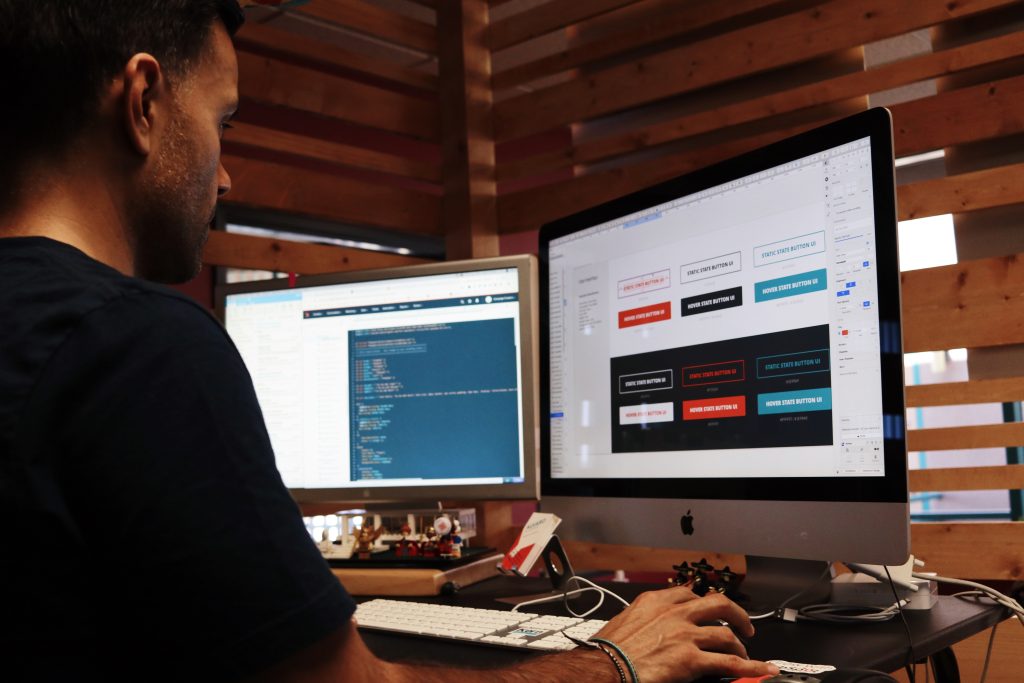As the internet grows ever more sophisticated and powerful, it has become increasingly important for businesses to have an effective website. After all, in today’s world, a successful business is not just about having quality products or services; it’s also about how you present them online.
Crafting the perfect website can seem overwhelming, but with our helpful web design guide, you can turn your dreams into reality!
Creating a great website isn’t easy – many variables are at play regarding aesthetics, usability, and accessibility. Plus, if you want to stand out from the competition, you need something special.
But don’t panic: we’ve got everything covered. From choosing the right platform for your needs to understanding SEO basics and beyond – read on for some simple tips and tricks to help get started crafting the perfect website of your very own!
Forget about spending hundreds of hours researching complicated coding techniques – by following these straightforward steps, and you’ll soon be able to create a visually stunning masterpiece that will draw customers directly toward your business without breaking any industry rules or regulations. So sit back, relax, and let us guide you through this journey!
Understanding User Interface Design
As the world shifts more and more to a digital realm, understanding user interface design becomes evermore important. It’s no coincidence that when designing a website, it is essential to consider how users interact with your web design – because if they don’t like what they see or find it difficult to navigate, they won’t stay for long.
This is why having an effective user interface (UI) design should be at the top of every designer’s list when crafting the perfect website. A well-designed UI helps make websites easier to use by making all necessary information accessible from one page, creating clear pathways for users to follow.
Plus, it can also help build trust between customers and businesses as customers feel informed about their experience on the site.
Designing an effective UI requires knowledge of various elements such as typography, color theory, layout design principles, etc. This means designers need to deeply understand each element to create something aesthetically pleasing and easy to navigate, which will ultimately lead to higher engagement levels and conversions on the website.
Establishing An Aesthetic Through Color And Typography
Creating an aesthetic for a website can be just as important as the technical elements. Color and typography play critical roles in crafting the perfect website, allowing users to understand the message conveyed on the page.
Color selection sets the tone by providing visual cues that help guide visitors through the site. Colors should be chosen with purpose, considering their psychological effects on people; warm colors invoke comfort, while cool tones create a feeling of professionalism. It’s also important to consider how different colors work together and if they clash or complement one another when placed side-by-side.
Finally, selecting hues that fit within brand guidelines will ensure a cohesive look throughout all marketing materials.
Typography choices also impact web design aesthetics, sending subtle messages about the personality of a product or service. Fonts come in many shapes and sizes, each conveying its style — from modern sans serifs to classic serifs, endless possibilities are available, making it easy to find something unique yet recognizable.
Properly pairing fonts helps establish page hierarchy and readability, ensuring content isn’t lost among competing typefaces. Selecting fonts with distinct personalities allows designers to communicate effectively.
From color combinations to font selections, creating an effective aesthetic for a website requires planning and thoughtful execution — no matter how small or large your project may be. Establishing a visually pleasing look through color and typography brings websites alive, offering strong first impressions that draw attention from potential customers!
Optimizing Navigation And Usability
Once you have established the aesthetic of your website, it’s time to focus on navigation and usability. This is an important step in crafting a successful website; after all, no matter how visually attractive it may be, users will likely move on to something else if they can’t find what they are looking for quickly and easily.
Take Google as an example – their homepage has a minimal design with few distractions and clear links to help people navigate the services or information they need. Similarly, Amazon’s layout allows customers to search for products without any clutter getting in their way. Both websites demonstrate effective design principles, which make them easy for users to interact with.
When designing a site, one should ensure that there are multiple ways of accessing content and features. Consider providing different access points, such as search functions and sorting options so visitors can get where they want to go quickly and easily. Additionally, consider creating pathways between related pages or sections, so visitors don’t feel lost when browsing your website.
By taking these steps into account during the web development process, you can create a user experience that encourages engagement and keeps people coming back repeatedly!
Integrating Responsive Design
To create a great website, ensuring the design looks and functions well on any device is important. Responsive design allows for this by automatically adjusting your site’s layout according to the user’s screen size. This means that users can access your content regardless of whether they use a laptop, tablet, or mobile device.
Responsive design also helps with accessibility. By ensuring that all elements of your website work properly on different devices, people with disabilities can use your site more easily. Additionally, responsive websites often include features like larger fonts and high-contrast colors, making them easier to read.
Integrating responsive design into web design offers multiple benefits: improved usability across different devices, greater accessibility for those with disabilities, and an overall better user experience. With these advantages in mind, it makes sense why responsive design should be included in creating a perfect website.
Developing Engaging Content
Developing engaging content is an essential part of crafting the perfect website. Good web design requires attention to detail, including having interesting and useful information on the page. Content should be well organized, easy to read, and relevant.
Content is what will keep visitors returning to a website time after time. It must have a personality to stand out from other websites with similar topics or themes. Here are three key elements when developing engaging content:

Photo by Campaign Creators on Unsplash
Quality Writing – Make sure the text is clear and concise, without typos or grammar errors.
Eye-Catching Images – Include visuals like photos or videos related to your topic, as they can draw readers in and help support your message.
Relevant Links – Add links throughout your content so readers can find more information if needed; however, don’t overdo it with too many external sources.
To make sure you create compelling content, think about who will be reading it and why they need this information. You want them to feel informed enough that they stay on your page long enough to explore further before leaving again, ensuring the experience remains enjoyable!
Optimizing For Search Engines
Once you have created engaging content, it is time to optimize your web page for search engines. Search engine optimization (SEO) ensures that potential visitors can easily find your website, and this step should not be overlooked. SEO involves various techniques, such as using keywords in headlines and body text, adding meta tags to the website’s back-end code, structuring URLs correctly, and more.
It is important to remember that SEO is an ongoing process; after making changes to improve your ranking in search results, you need to monitor your progress and consistently make further adjustments, if necessary.
Additionally, with algorithms constantly evolving, staying up-to-date with best practices for SEO is essential to achieve long-term success. Websites need frequent monitoring and maintenance to remain competitive and relevant within their respective markets.
The goal of any web design project should be creating a site that looks good visually and is optimized for maximum visibility online – therefore, taking the time to understand the basics of SEO will help ensure websites are well positioned against competitors when users conduct searches. With proper implementation of these strategies, businesses can see improved traffic levels over time which leads to higher conversion rates.
Integrating Security And Reliability
How secure and reliable is your website? This is an important question to ask when crafting the perfect website. After all, security and reliability are essential components of any successful site. In this section on web design, we will explore the ins and outs of integrating security and reliability into a website.
When maintaining user data, server-side maintenance must be considered to ensure that users’ information is safe from cyber-attacks or malicious software. A good way to ensure your website is secure is using cryptographic protocols such as SSL/TLS certificates. These encrypt data sent between the browser and the server so no third party can intercept it.
Additionally, implementing two-factor authentication for logins ensures that only authorized people can access sensitive data stored on the site.
Reliability is also key for a well-crafted website. Services like caching and content delivery networks help keep websites running quickly despite high traffic spikes; otherwise, sites can become slow or unresponsive due to server overloads.
Furthermore, having backups of webpages ensures that if something goes wrong during development, there’s still a copy available for recovery – thus saving time (and money) in case of unexpected errors or crashes.
These measures will secure your website while ensuring its reliable performance over time – vital steps in creating a successful online presence!
Analyzing Performance And User Behavior
As web design evolves and becomes more intricate, website owners and developers must consider how users interact with their sites. This means analyzing performance and user behavior to make better decisions about a website’s development direction.
By tracking metrics such as page views, time on page, bounce rate, session duration, and conversion rates, designers can gain insight into what works best for the target audience of a particular website. Additionally, understanding user behaviors, such as which pages are being visited most often or if customers are using certain features over others, may allow webmasters to focus their efforts more effectively.
From this data collection process, recommendations can be made that will help refine and improve the overall experience of a website. For example, based on customer interactions with a web page or feature, small changes may need to be implemented to increase engagement or satisfaction.
It is then important for designers to pay attention to these analytics before making sweeping updates to create an engaging online presence tailored specifically for their visitors.
Conclusion
In conclusion, crafting the perfect website is an intricate process that requires knowledge of user interface design, aesthetic design principles, navigation, and usability optimization, responsive design implementation, content development strategies, search engine optimization techniques, security measures, and analytics.
It’s a tall order for any web designer or business owner to take on alone. Still, with some dedication and patience, you can create a website that follows the best web design practices while ensuring it reflects your brand identity.
Despite all this work required to build a successful website, some still feel like they don’t have the time or money necessary to invest in such an endeavor.
However, by spending wisely and being mindful of the decisions made during each step of the design process, businesses can craft high-quality websites without breaking the bank. Furthermore, these wise investments will often pay off in increased customer engagement and better SEO rankings, which leads to more conversions and sales over time.







Recent Comments